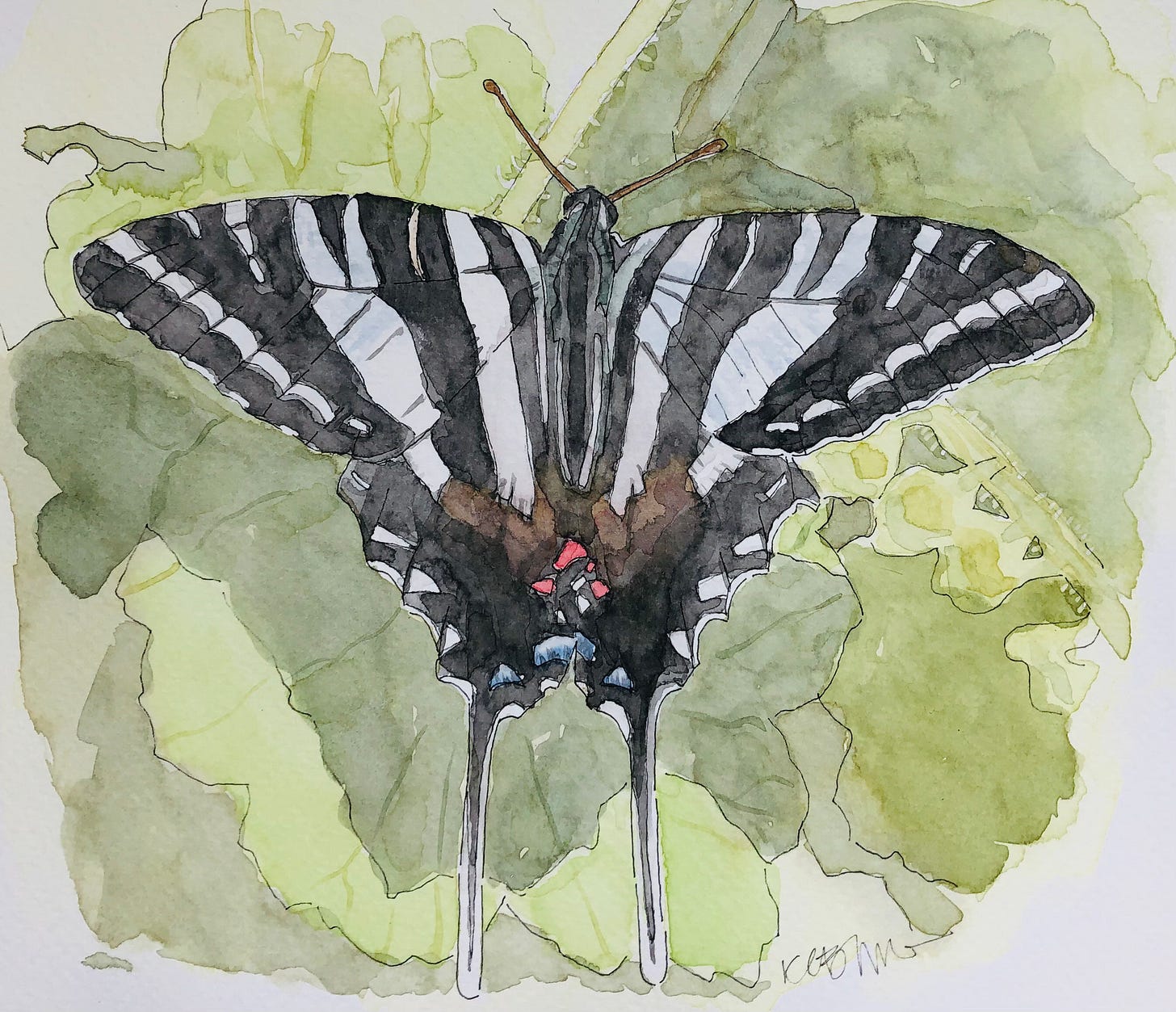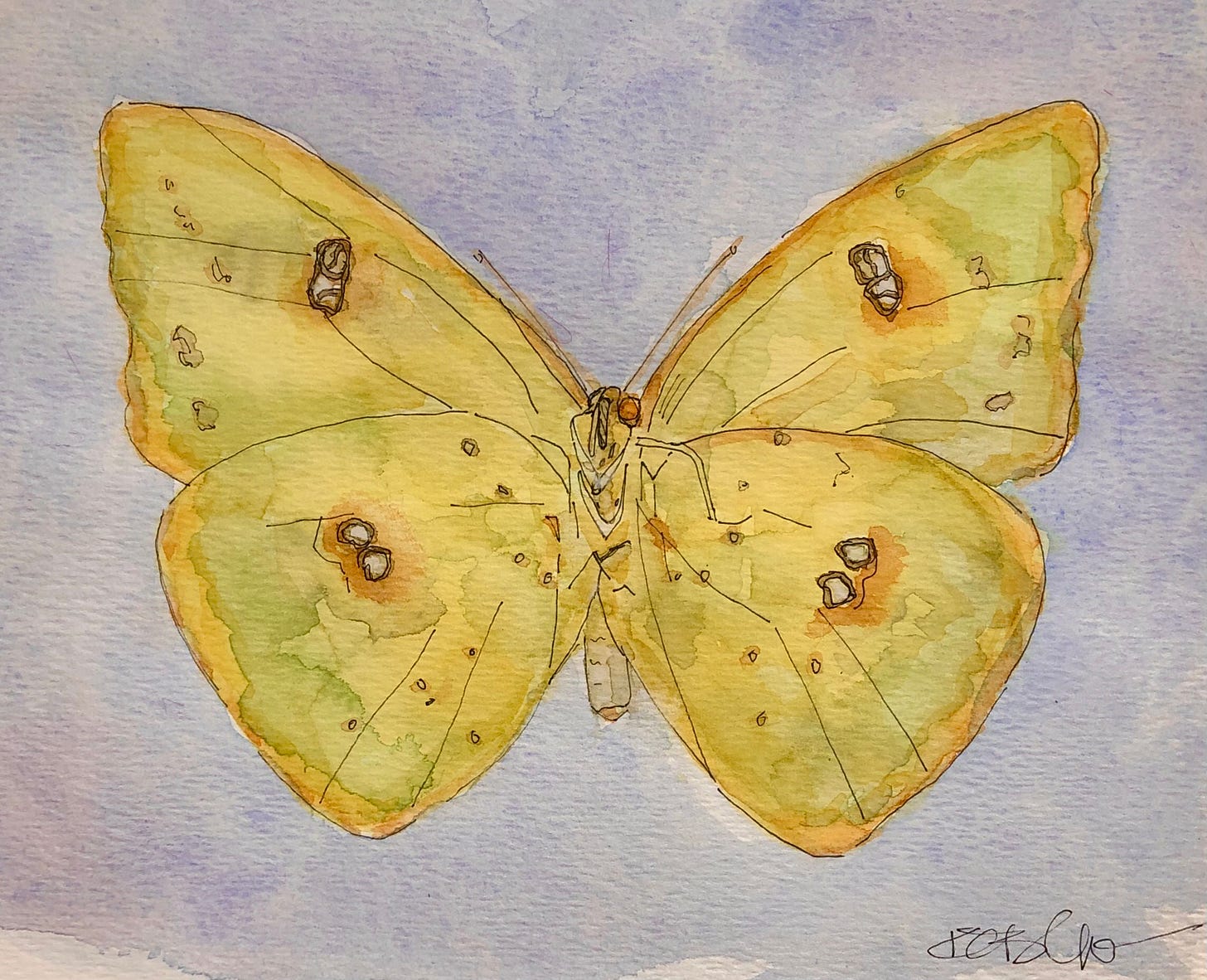
Butterflies have been called the flowers of the sky. Even if you’d never laid eyes on an actual butterfly but had only read a list of species names, you’d get the right idea. Spoken aloud, names like “glasswinged” and “golden-banded” land fragile on the ear, while “purple hairstreak” and “peacock pansy” suggest something untamed. Maybe you can easily picture flamboyant butterflies flitting here, there and everywhere, but the truth is they are not endless, nor are they everywhere.
Around the globe, there are 17,500 species of butterflies and some are in serious decline. The most iconic butterfly to Americans is likely the Monarch. Last summer, the Monarch butterfly was added to the “Red List” of endangered species by the global authority on the natural world, the International Union of Conservation of Nature.1 Butterflies of all kinds once seemed to dance over flowers and yards all over the state on sweltering summer days but not so much anymore. This week, I interviewed a Georgia expert on butterflies to ask why. Today, I am sharing highlights of my talk with Phi Delestrez, the Resource Manager for Habitats with the Georgia Department of Natural Resources. Delestrez is also a nature-lover who appreciates and protects butterflies and their habitats.

“Yes, I’m the kind of guy who takes the whole family along on vacation to see some rare butterfly,” Delestrez said this week. “And my yard? Parts of it are wild, grown-up. If you saw it, you’d think that guy needs to mow the grass.” He laughed then went on to tell me about his job. That day, Delestrez was overseeing a prescribed burn in one of the DNR’s natural areas. Prescribed burns are land management tools that help with forest regeneration and protect natural habitats for wildlife.
Early years? I grew up in Chicago where there was very little of the natural world––basically a biological desert. We’d get excited if we saw a Blue Jay outside. Maybe that’s why I went into this type of work.
Early career? I studied ecology at Southern Illinois University. One of my first jobs was as a seasonal park ranger at Rend Lake, Illinois. I loved the beautiful prairie grasslands there and learned a lot about how to manage the landscape in ways that are beneficial to insects, birds––everything really.
How did you learn so much about butterflies? After I moved to Georgia 20 years ago, I was working for the Georgia Department of Natural Resources and, of course, meeting the locals who care about the land, the creatures. I somehow met this couple from Musella, Ga. who loved butterflies. It was that simple, really. They’d take me on these wonderful walks and we’d do butterfly counts around Panola. I guess their enthusiasm just rubbed off on me. They were great, so knowledgeable.

What can people do to help butterflies? Well, that’s a great question. I’ll give you four things:
Start leaving an area of the lawn uncut. I know people love to mow the grass but start leaving a section undone. Let it go wild to help the pollinators.
Learn the names of your local butterflies and learn the name of their host plant. Butterflies typically have a special host plant. (See this chart specific to Georgia.)
If you decide to plant host plants for butterflies, only shop from your local native plant nursery. I’m not a fan of the big box stores because the plants often have pesticides on them. Pesticides can last in a plant for 5-6 years.
Learn all you can. I suggest Radiolab’s podcast episode, Of Bombs and Butterflies. It is entertaining and shows all the challenges a butterfly expert faced as he tried to protect an endangered butterfly species over at Fort Bragg, N.C. Also, the North American Butterfly Association (NABA) is my go-to resource for information. I’m a fan of community science, and if you want to get involved as a volunteer on a butterfly count, the NABA has maps which shows local counts.
Tell me about your dream butterflies. Once we went out into Oaky Woods in Houston County, Ga. The weather conditions were right, and the host, a Field Bean plant, was all over the place. And we got lucky! I spotted the rare––practically mythical––Golden-banded Skipper. Just the one. It was amazing, a magical experience. Another time, I took the family on vacation to search for the Regal Fritillary, another rare species. We drove up to the far side of Missouri, near Joplin. It was something like a 100 degrees that day, quite windy, and violets, the host plant, were blooming nearby. Well, out in the grasslands we got lucky and found one. The Regal Fritillary is super rare. So exciting to see it. A day I’ll always remember.
What gives you hope for the butterflies? More and more people are starting to care for and learn about the ethics of taking care of the land. In nature, as you know, everything is connected, so taking care of the land is taking care of the insects. I hope the public, especially the young folks, step forward to learn and get involved. Volunteering in community science projects can help, along with reading, learning, paying attention. The next generation, I hope, can do a better job.
In 2019, biologist Nick Haddad published “The Last Butterflies: A Scientist’s Quest To Save A Rare and Vanishing Creature.” Haddad is featured in the Bombs and Butterflies podcast mentioned above, and his name came up frequently when I did research on what’s current in the U.S. in the butterfly world. To underscore Delestrez’s points, I’ll end with a Haddad’s quote from a Minnesota Public Radio program about butterflies:
“...what I like to encourage people to do is set aside just a little bit of their yard to add flowers for pollinators and butterflies or food plants or butterfly caterpillars,” said Haddad. “We can all just add a little bit of butterfly habitat … It makes a difference. If many people do that, then all of a sudden we have much more habitat for butterflies and other pollinators. And so, you know, we all do a little bit, but if everybody does a little bit it really does add up.”
Give me some of that old-time action.
As I began researching facts about butterflies and pollinators this week, I reread “Do you have climate anxiety?” a story I’d torn out of Parade magazine late last year. The one-page article reported that some people are seeing therapists to help them deal with their worries about the environment. As I revisited the story, I felt my own worries surface. I’ve been drafting articles for “The Everyday Scientist” for 10 straight weeks. Over and over, I’ve shared scientific data with alarming facts about this species listed as endangered, or that creek found to be polluted, or, and here’s a sad specific, that preliminary approval has been given to allow mineral mining right next to North America’s largest swamp, the 10,000-year-old Okefenokee. It can get depressing. The Parade article included this line: “Discussing your feelings with others empowers you and enables you to take constructive action.” 2 I underlined the words, constructive action and have focused there ever since. Thanks for reading today as I once again write to give voice to community science. Try a project. Butterfly counts are coming up this summer, you can find information at the NABA website. Use the time you would have spent mowing the grass planning ways to help science!
Migratory monarch butterfly now endangered - ICUN Red List.
Screenshot of Parade article. Link to article no longer available.






I love butterflies! Great article. As always, informative and engaging- we have lots in our yard
What a meaningful article! Can imagine the thrill of seeing some of those rare species. I am inspired to find out about host plants. And, yes climate fatigue, feels very real. Good to remember to treat it with some constructive action. Thanks Pam!